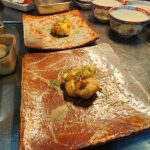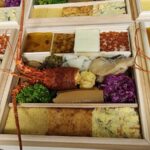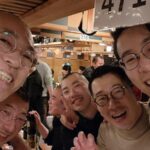
Garrick, chose to stage in Tokyo, Japan in order to connect to his Japanese roots but also to integrate himself into the Japanese culture of hospitality, cooking techniques and ingredients.
I am a fourth generation Japanese American born in California. I have always been curious about my Japanese background and I didn’t have the opportunity to travel to Japan in the past so to my excitement and glee, I received a Ment’or Grant to go abroad and learn more about the culinary world. I chose Japan not only to connect back to my Japanese roots, but also to fully integrate myself into Japanese cuisine with high anticipation of the ingredients and techniques, and also just as importantly, the hospitality.
This past winter of 2023, I chose to go to Tokyo, Japan and stage at Kohaku—a three star Michelin restaurant in Kagurazaka, Shinjuku. Kohaku is operated under the Ishikawa group, which has a wide number of operations that includes Kagurazaka Ishikawa, another three star Michelin restaurant. Kohaku is also run by the youngest chef to earn three stars in Japan (age 36 in 2015), Chef Koji Koizumi. Koizumi-san is a warm, passionate, and ultimately grounded individual which, when doing my research, enticed me to choose Kohaku. Not only that, Koizumi-san pushes the boundaries of Japanese food, but still stays true to the facets of traditional Japanese cuisine of Washoku.
My first day after stepping off the plane was working at Kagurazaka Ishikawa. It was there where I was able to meet Ishikawa-san as well as his team. The day consisted of light knife work, as well as breaking down an extraordinary amount of snow crab. The chefs I was working with would tell me how to properly handle the food they would be serving that day, always washing their hands from contaminants and wearing gloves to preserve the ingredients' natural flavor. The sheer level of cleanliness was reminiscent of the many other Japanese restaurants I’ve worked at in California. The service portion of the day consisted of me watching the chefs cook, plate, and move around the kitchen almost as if everything was choreographed. I was able to help plate after watching them seamlessly flow through the natural chaos that ensues during service. They even offered many of the dishes they served that night so I could understand the taste and flavor profile that Kagurazaka Ishikawa proudly showcases. Needless to say, I was blown away by how clean and simple yet complex the flavors were of each dish.
The following two months consisted of me working at Kohaku. The restaurant itself is small, comfortably seating 25 guests in one seating. The greatest lesson I learned was basic Japanese preparation techniques. Like Kagurazaka Ishikawa, everything was cleaned extremely well. And to further eliminate flavor contaminants, dashi was used to rinse many of the dishware prior to use. The dashi itself is complex and made fresh daily. Throughout my time at Kohaku, I was tasked with a number of preparations which included but not limited to, snow crab processing, breaking down tai fish, weighing out individual bites for each dish, and creating the take home onigiri for each guest. Each table was given their own donabe clay pot which consisted of dashi gohan, tai or crab meat, chives, and gold flakes. Each donabe pot was presented tableside by Koizumi-san and then brought back to the kitchen to get portioned out into individual chawan bowls. Whatever was left over was used for the guest’s take-home onigiri.
During the small amount of downtime during service, the other chefs would teach me something new about Japanese cuisine. Technique wise, they taught me the various skewering techniques used in Japanese cooking over binchotan coals. This was my first time grilling fish over a real binchotan and I needed to adjust my own cooking techniques due to the intensity of the heat. Another technique they pushed me to improve upon was “katsuramuki” which is the knife technique of creating razor thin sheets of a particular vegetable/root (daikon in this case). There were many other culinary techniques that the chefs taught me, but I would have to say the greatest lesson I learned was how to manage a team and restaurant of that caliber through “omotenashi” which means “to wholeheartedly look after the guests.” Without any verbal discussion, Chef Koizumi and the Kohaku team demonstrated how an Executive Chef or Sous Chef leads their team to success. Everyone works as a unit and shares responsibility for each preparation. Everyone is spoken to directly and firmly, but also compassionately. They empower each other through a positive work environment, respect, and critiquing instead of criticizing. These are the aspects of kitchen leadership I hope to convey when I return to Nisei. Not only that, everyone in the kitchen is responsible for washing dishes, running food to the guests, drink preparation, and resetting tables. Omotenashi is a term that I hold dearly as a cook as it was one of the first concepts I learned during my early years. My first Japanese restaurant taught me this mindset—to do it all, and show ultimate hospitality.
The last week of Kohaku was the most memorable. It was my first time spending Christmas and New Years internationally, and my first time creating classic upscaled Osechi jubako boxes which are essentially a two-tiered bento box. Osechi-ryori are special New Year's foods that can commonly consist of ebi, kuromame, kazukuri, and datemaki just to name a few. Both Kohaku and Ishikawa had their own versions of Osechi boxes—consisting of around 30 individual bites—each using prime ingredients (caviar, uni, lobster, just to name a few) and traditional cooking techniques for their guests to enjoy. The whole process took four days for preparation including packing each individual jubako box with each pre-made dish. If I had to venture a guess, almost the whole company’s chefs and management created roughly 400 Osechi boxes for delivery by New Year’s Eve.
The two months that I’ve spent at Kohaku have been a dream come true. Thank you to Ment’or for choosing me to be a recipient of the grant. Having the opportunity to work in Japan, and learn about its food and culture has been mind blowing. Not only working in Japan but also being able to talk to other chefs and learning their skill sets and recipes has broadened my culinary expertise. Before I came to Japan, I had doubts if my skill level was appropriate for a three star restaurant, however, after applying myself through this humbling experience and with each new skill set I have ascertained, I am eager to bring them back to San Francisco and lead my team to greater heights and achievements through omotenashi. Looking further into the future, I hope to be able to further develop new dishes for Nisei and build a new izakaya style menu for the bar we own as well.



